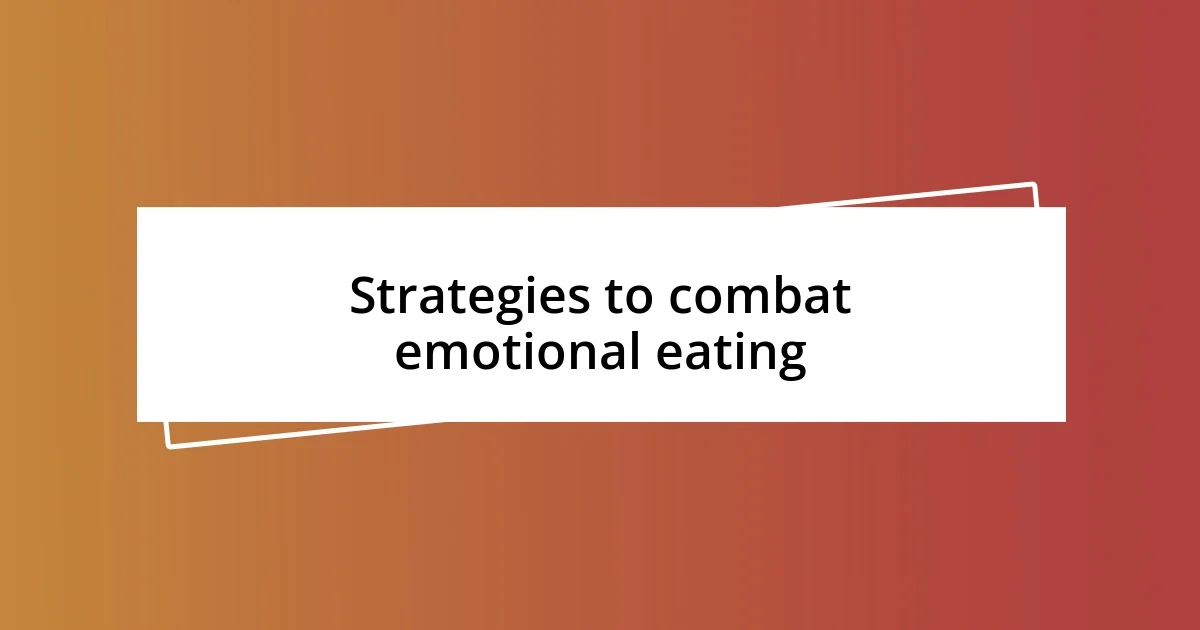Key takeaways:
- Emotional eating often arises from the desire to cope with feelings rather than true hunger, highlighting the importance of identifying emotional triggers.
- Incorporating mindfulness, keeping a food journal, and building a support system are effective strategies to combat emotional eating and address underlying emotions.
- Maintaining long-term changes requires consistent self-reflection, accountability, and mindfulness practices to manage cravings and reinforce healthier choices.

Understanding emotional eating
Emotional eating often stems from a desire to cope with feelings rather than physical hunger. I remember times when I found myself reaching for a bag of chips after a stressful day at work, not because I was hungry, but to soothe the anxiety swirling in my mind. Isn’t it fascinating how food can become a comfort when emotions run high?
What I’ve come to understand is that emotional eating can create a cycle of guilt and shame. I’ve felt that heavy weight in my chest after indulging in a chocolate cake to mask a rough day—only to find that the fleeting pleasure was shadowed by regret. This experience left me questioning: what if we could address our emotions in healthier ways instead of turning to food?
Ultimately, identifying the triggers of emotional eating is crucial. For instance, during moments of sadness or loneliness, I’ve noticed a strong urge to binge-watch shows while snacking. It’s a way to escape, but such patterns often lead to a deeper examination of our emotional health. Have you ever found yourself turning to snacks in a similar situation? Recognizing these patterns is the first step toward making meaningful change.

Recognizing triggers for emotional eating
One of the most eye-opening moments in my journey was when I began to pinpoint the situations that triggered my emotional eating. It wasn’t just about cravings; it was linked to specific feelings or circumstances. For example, after an argument with a friend, I found myself rifling through my pantry, searching for anything to munch on—hoping the crunch of chips would drown out the discomfort of the conflict. This realization made me think: what if I could confront my emotions rather than bury them under a pile of snacks?
Recognizing these triggers involves tuning in to our emotional state and the context surrounding our food choices. Here are some common triggers I’ve encountered:
- Stressful workdays: Often leads me to seek comforting, high-calorie foods as a way to unwind.
- Loneliness or boredom: I sometimes find myself mindlessly eating while scrolling through my phone, using food to fill emotional voids.
- Celebrations and gatherings: I’ve noticed my tendency to overindulge during these times, viewing food as a centerpiece of joy rather than nourishment.
- Fatigue: When I’m tired, I tend to reach for quick, easy snacks instead of addressing my need for rest.
- Negative emotions: Feelings like sadness or anger often prompt cravings for sweet treats, which I then use to lift my mood momentarily.
By becoming aware of these emotional cues, I realized I could take a more proactive approach, exploring healthier coping mechanisms that address the root of the feelings instead of just their symptoms.

Strategies to combat emotional eating
When I started to tackle emotional eating, I found incorporating mindfulness into my daily routine to be highly beneficial. Practicing mindfulness helped me focus on my emotional state before reaching for food. I remember one evening feeling overwhelmed while cooking dinner; instead of grabbing a snack, I paused, took a few deep breaths, and acknowledged my feelings. That moment of self-awareness not only reduced my urge to eat but also allowed me to deal with the emotions directly.
Another strategy I found effective is keeping a food journal. At first, I was hesitant to write down everything I ate, fearing it would be tedious. But when I began to also document my feelings and activities alongside my meals, I started spotting patterns. I can distinctly recall an afternoon where I noted down excessive snacking while stressed about a project deadline. This insight worked wonders, pushing me to find alternative ways to manage my stress, such as taking a brief walk to clear my head.
Lastly, I can’t understate the importance of building a support system. Sharing my journey with friends helped me stay accountable. I remember confiding in a close friend about my challenges, and surprisingly, I learned that they too struggled with emotional eating. Our regular chats provided not just understanding but also a sense of community, which made those tough moments a bit more manageable.
| Strategy | Description |
|---|---|
| Mindfulness | Tuning into emotions before eating; taking deep breaths during stressful moments. |
| Food Journal | Documenting meals alongside feelings to identify patterns in emotional eating. |
| Support System | Engaging friends or family to share experiences and hold each other accountable. |

Developing mindful eating practices
To develop mindful eating practices, I’ve found that creating a dedicated mealtime can significantly change my relationship with food. I started setting aside my phone and TV during meals, allowing myself to focus solely on the flavors and textures on my plate. Have you ever really savored a meal without distractions? There’s something refreshing about truly experiencing food rather than consuming it mindlessly.
In my experience, using visualization techniques before meals can also be transformative. I recall a time when I felt stressed about work and sat down to eat a heaping plate of pasta. Instead of diving right in, I closed my eyes and pictured how I wanted to feel—satisfied, energized, and content. That moment of visualization not only enhanced my enjoyment but also helped me recognize when I was full. It’s like reconnecting with my body in a way I hadn’t done before.
Finally, I discovered that practicing gratitude for my meals enriches my eating experience. For instance, before dinner, I now take a moment to appreciate the colors, smells, and the effort that went into preparing it. This simple act of gratitude shifts my focus from merely eating to genuinely valuing the experience. When was the last time you paused to reflect on what you’re eating? Embracing this mindset can make each meal feel special rather than just another task on your to-do list.

Building a supportive environment
Building a supportive environment was a game-changer for me in my battle against emotional eating. I distinctly remember when I decided to invite my friends to share dinner once a week. It wasn’t just about the food but the camaraderie that emerged around the table. We would talk, laugh, and, on some nights, even share our own struggles with food and emotions. Isn’t it amazing how communal dining can transform a solitary experience into a shared journey of support?
Having family understand my journey was another crucial step. I sat down with my parents one Sunday evening and opened up about my battles with emotional eating. To my surprise, they offered to be my accountability buddies. Whenever I’d reach for a snack during a tough day, they’d casually check in, asking if I felt hungry or just stressed. That gentle reminder, delivered with love, kept me mindful of my choices. Do you have family members or friends who could be your cheerleaders?
Additionally, creating a nurturing space at home has been instrumental. I redesigned my kitchen to make it a comforting space rather than a stress zone. Soft colors, calming scents from essential oils, and even inspirational quotes on the walls invite a peaceful atmosphere. It’s incredible how the environment influences our mindset. When you walk into a space that feels warm and encouraging, don’t you feel more inclined to take positive steps for yourself? By surrounding myself with supportive influences, I’ve forged a path that feels less daunting and much more manageable.

Tracking progress and setbacks
Tracking my progress with emotional eating has been enlightening. I remember vividly the first time I wrote down my food intake and how I felt before and after meals. At first, it felt tedious, almost like an obligation, but over time, it revealed patterns I hadn’t noticed before. How many times have you eaten something just because it was in front of you, rather than because you were genuinely hungry? Keeping track heightened my awareness, nudging me toward more intentional eating habits.
However, setbacks are natural and part of the journey. Recently, I had a week where stress from work led me back to mindless snacking. Instead of fretting over my slip, I wrote it down, reflecting on what triggered those habits. That little act of acknowledgment transformed my shame into understanding. Isn’t it fascinating how recognizing our patterns can help us regain control? This time, I focused on reconnecting with my emotions before reaching for comfort food, which helped me prevent future lapses.
I also found that celebrating small successes not only motivated me but made the process enjoyable. I recall when I went an entire week without indulging in late-night snacks, and I treated myself to a relaxing bubble bath as a reward. Doesn’t it feel good to honor our progress, no matter how small? These moments remind me that every step is part of a larger journey, making both progress and setbacks essential learning experiences.

Maintaining long term changes
Maintaining long-term changes often requires consistent self-reflection. For me, that meant dedicating a few moments each day to check in with myself. I remember sitting on my couch with a cup of herbal tea, asking myself, “What drove me to emotional eating today?” This simple practice helped me stay connected to my feelings and reinforced my commitment to healthier choices. Have you ever taken the time to reflect on your actions and intentions?
I also found that incorporating mindfulness techniques into my routine made a tangible difference. During a particularly overwhelming week, I turned to meditation. I would sit, breathe deeply, and visualize my goals while observing my cravings without judgment. It was empowering! I discovered that even in moments of temptation, I could choose to respond differently. Is there a practice that resonates with you that could help you navigate those tricky moments?
Additionally, maintaining accountability shifted the trajectory of my journey. I stumbled upon the idea of a weekly check-in with a friend who was also working on her relationship with food. Sharing our wins and struggles created a communal sense of responsibility. I recall the exhilaration I felt after sharing my progress and hearing my friend cheer for me. Isn’t it uplifting to have someone else rooting for your success? By fostering not just personal commitment, but shared motivation, I realized we’re far more likely to sustain our changes when we feel connected and supported by others.














